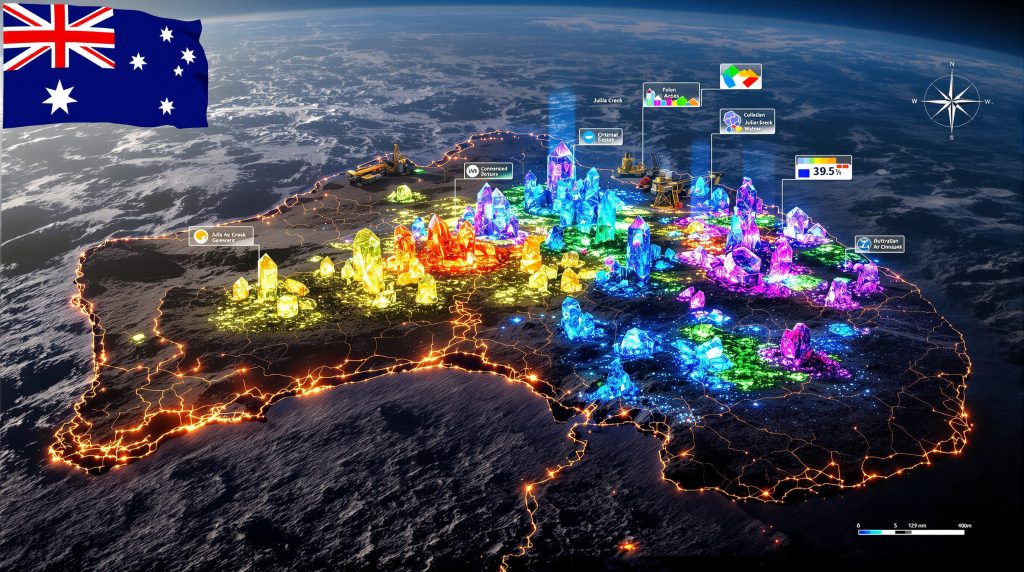Georgetown-Julia Creek: Geoscience Australia's Third Deep Dive Target Unveiled
Federal Resources Minister Madeleine King recently announced the Georgetown-Julia Creek region in northwest Queensland as the third deep dive project location under Geoscience Australia's comprehensive $3.4 billion Resourcing Australia's Prosperity initiative. This strategic selection underscores the region's potential significance in Australia's resource development landscape, particularly for critical minerals essential to modern technologies.
The Georgetown-Julia Creek region joins two previously announced deep dive areas: the Birrindudu region spanning the Northern Territory and Western Australian border, and the Delamerian region covering parts of South Australia, New South Wales, and Victoria. This selection process is part of a methodical approach to identifying and assessing regions with untapped resource potential across Australia.
How Do Geoscience Australia's Deep Dive Projects Work?
Purpose and Methodology
Geoscience Australia's deep dive projects represent a systematic approach to resource identification and assessment. These comprehensive geological investigations aim to deliver detailed, multi-commodity assessments of selected regions while enhancing understanding of resource prospectivity in areas with untapped potential.
The methodology involves advanced geological surveying techniques including high-resolution geophysical mapping, geochemical sampling, and stratigraphic analysis. Teams collect extensive field data which undergoes rigorous interpretation to create detailed three-dimensional models of subsurface geology. This process helps identify potential mineral deposit tiers guide and groundwater systems that might otherwise remain undiscovered.
By utilizing state-of-the-art data collection methods and modern analytical techniques, Geoscience Australia provides industry stakeholders with scientific insights that substantially reduce exploration risks. This approach effectively bridges the gap between initial resource potential identification and viable commercial exploration.
Selection Criteria for Deep Dive Regions
The Georgetown-Julia Creek region was selected following a rigorous evaluation process. Geoscience Australia employs specific criteria when identifying potential deep dive targets:
- Geological indicators suggesting significant but undeveloped mineral deposits
- Proximity to existing infrastructure to facilitate potential development
- Evidence of multiple commodity potential rather than single-resource prospects
- Favorable structural geology indicating mineral-trapping mechanisms
- Limited previous exploration relative to geological potential
- Presence of potentially viable groundwater systems to support future development
- Strategic alignment with critical minerals strategy needs for emerging technologies
This methodical selection process ensures that government resources target regions with the highest probability of yielding discoveries that contribute to Australia's resource security and economic prosperity.
Why is the Georgetown-Julia Creek Region Significant?
Geological Potential
The Georgetown-Julia Creek region spans a geologically diverse area of northwest Queensland with distinctive formations dating back to the Proterozoic era. This region's complex geological history has created favorable conditions for mineral formation through various tectonic events and depositional environments.
Geological assessments indicate the area potentially hosts:
- Copper-gold porphyry systems similar to those found in other parts of Queensland
- Sedimentary basin-hosted vanadium deposits particularly in the Julia Creek area
- Rare earth element occurrences associated with alkaline intrusions
- Strategic battery minerals including cobalt and nickel in lateritic profiles
- Phosphate deposits with potential agricultural applications
- Untapped groundwater resources in deeper aquifer systems
The region contains the boundary between the Georgetown Inlier (a Proterozoic basement block) and younger sedimentary basins, creating favorable conditions for mineral deposit formation at geological unconformities and contact zones.
Strategic Importance
This region's selection as the third deep dive target underscores its strategic importance to Australia's resource sector for several reasons:
- Its potential contribution to critical mineral supply chains crucial for renewable energy technologies
- The opportunity to develop new resource provinces in historically underexplored areas
- Potential to support regional economic diversification in northwest Queensland
- Strategic positioning to supply minerals essential for battery manufacturing and electronics
- Possibility of establishing new mining operations that support Australia's post-pandemic economic recovery
Regional development potential extends beyond direct mining activities to include processing facilities, transportation infrastructure, and community support services, creating a multiplier effect for local economies.
What is the Resourcing Australia's Prosperity Initiative?
Program Overview and Funding
The Resourcing Australia's Prosperity initiative represents a landmark commitment to Australia's long-term resource security and economic development. Key features include:
- Total funding allocation of $3.4 billion
- Comprehensive 35-year program timeline allowing for long-term planning
- Focus on strategic minerals essential for emerging technologies
- Integration of groundwater assessment alongside mineral potential
- Coordinated approach across multiple government departments and scientific agencies
This initiative stands as one of Australia's most significant investments in geoscientific research, reflecting the critical importance of resource development to national prosperity. The program's structure allows for sustained investigation rather than short-term project cycles, enabling more thorough scientific assessment.
Long-term Vision and Targets
This initiative forms part of Australia's long-term resource strategy with an ambitious scope:
- Six deep dive regions planned for assessment during the program's first decade
- Creation of comprehensive three-dimensional geological models for target regions
- Development of new exploration methodologies applicable to Australia's unique geology
- Progressive public release of pre-competitive data to stimulate private investment
- Regular review of mineral priorities to align with evolving technology needs
The program demonstrates forward thinking in its recognition that tomorrow's resource needs may differ substantially from today's priorities, particularly as technology continues to evolve rapidly.
How Will These Deep Dive Projects Benefit Australia?
Economic Benefits
The Georgetown-Julia Creek deep dive project, along with the broader initiative, is expected to deliver substantial economic benefits:
- Stimulation of exploration investment in previously underexplored regions
- Job creation across technical fields including geology, geophysics, and environmental science
- Development opportunities for regional communities near resource discoveries
- Potential establishment of new mining operations supporting regional economies
- Downstream processing opportunities aligned with national manufacturing priorities
By reducing exploration risk, these projects effectively lower the barrier to entry for companies considering investment in Australian resource development. This approach has proven successful in similar pre-competitive data initiatives internationally.
Environmental and Community Considerations
The initiative incorporates important environmental and community factors:
- Assessment of groundwater resources alongside mineral potential
- Consideration of land use compatibility with existing agricultural activities
- Identification of areas suitable for development with minimal environmental impact
- Community engagement to ensure local perspectives inform planning processes
- Focus on resources needed for lower-carbon technologies supporting climate goals
This balanced approach recognizes that sustainable resource development must consider environmental impacts and community benefits alongside economic potential.
What's Next for Geoscience Australia's Deep Dive Program?
Timeline and Future Targets
The Resourcing Australia's Prosperity initiative follows a structured implementation plan:
| Deep Dive Phase | Target Region | Current Status | Expected Outcomes |
|---|---|---|---|
| Phase 1 | Birrindudu region | Data collection underway | Identification of mineral systems spanning NT/WA border |
| Phase 2 | Delamerian region | Initial assessment stage | Understanding of deep geological structures across three states |
| Phase 3 | Georgetown-Julia Creek | Recently announced | Assessment of critical mineral and groundwater potential |
| Phases 4-6 | To be determined | Planning stage | Selection based on emerging priorities and initial findings |
The initiative's phased approach allows for refinement of methodologies based on findings from earlier deep dives, creating a continuous improvement cycle that enhances the effectiveness of subsequent regional assessments.
Leadership and Implementation
The implementation of these ambitious projects involves coordination across multiple scientific disciplines. Geoscience Australia CEO Melissa Harris has emphasized the importance of collaborative approaches, bringing together expertise in:
- Geophysical surveying and remote sensing
- Geochemical analysis and laboratory testing
- Hydrogeological assessment and groundwater modeling
- Data management and digital information systems
- Stakeholder engagement and community relations
This multidisciplinary approach ensures comprehensive assessment of each region's resource potential from multiple scientific perspectives.
How Do These Projects Support Australia's Critical Minerals Strategy?
Alignment with National Priorities
The deep dive projects directly support Australia's broader critical minerals strategy by:
- Identifying domestic sources of minerals currently dominated by concentrated global supply
- Supporting resource security for manufacturing sectors reliant on specialized materials
- Building Australia's reputation as a reliable supplier of ethically sourced minerals
- Diversifying Australia's mineral export profile beyond traditional commodities
- Supporting sovereignty in supply chains for defense and strategic technologies
This alignment ensures that scientific efforts contribute directly to national economic and strategic objectives rather than operating in isolation.
Net-Zero Transition Support
These geological assessments specifically target resources needed for Australia's net-zero transition:
- Battery minerals including lithium, cobalt, and manganese
- Rare earth elements for permanent magnets used in electric motors
- Materials needed for solar panel and wind turbine manufacturing
- Elements required for hydrogen production catalysts and storage materials
- Minerals essential for energy-efficient electronics and grid infrastructure
By focusing on these materials, the initiative helps position Australia as a key supplier for global decarbonization efforts while creating domestic opportunities in clean energy manufacturing.
FAQ: Geoscience Australia's Deep Dive Projects
What is a "deep dive" in geological terms?
A geological deep dive represents a comprehensive, multi-disciplinary assessment of a region's resource potential. Unlike traditional geological mapping, deep dives integrate multiple scientific techniques including:
- Advanced geophysical surveys to image deep geological structures
- Systematic geochemical sampling to identify mineralization patterns
- Stratigraphic drilling to understand rock sequence relationships
- Three-dimensional modeling of subsurface geological architecture
- Integration of historical exploration data with new findings
This holistic approach provides a much more complete understanding of resource potential than conventional geological assessments.
How are deep dive regions selected?
Regions are selected through a rigorous evaluation process considering:
- Preliminary geological indicators suggesting mineral potential
- Limited previous exploration relative to geological complexity
- Strategic alignment with critical mineral priorities
- Presence of suitable infrastructure or development potential
- Community receptiveness to resource development
- Compatibility with existing land uses and environmental values
The selection process involves both scientific assessment and strategic consideration of national resource priorities.
When will results from the Georgetown-Julia Creek assessment be available?
While specific timelines haven't been announced, deep dive projects typically follow a multi-year assessment schedule:
- Initial planning and data compilation: 6-12 months
- Field surveys and data acquisition: 1-2 years
- Laboratory analysis and data interpretation: 1-2 years
- Publication of findings and data packages: Ongoing throughout the project
Preliminary findings may become available within 18-24 months, with comprehensive assessments typically requiring 3-4 years for completion.
How can industry stakeholders engage with these deep dive projects?
Industry stakeholders can engage through multiple channels:
- Industry forums and technical presentations organized by Geoscience Australia
- Formal consultation processes during project planning phases
- Access to progressively released data through online portals
- Participation in collaborative research partnerships
- Attendance at geological conferences where findings are presented
Early engagement allows companies to align exploration strategies with forthcoming data releases and incorporate new scientific insights into their planning processes.
Further Exploration
The Georgetown-Julia Creek deep dive project represents a significant opportunity for northwest Queensland and Australia's resource sector. As this project progresses, Geoscience Australia will provide additional information through technical publications, data releases, and stakeholder engagement activities.
Industry participants, researchers, and community members interested in following the project's development can access updates through Geoscience Australia's online platforms and participate in future information sessions. This collaborative approach ensures that the scientific insights gained benefit all stakeholders while contributing to Australia's resource knowledge base and economic prosperity.
The latest geoscience australia deep dive target revealed shows promising potential for companies involved in drilling programs types and those focused on mineral exploration importance. Furthermore, the detailed drilling results interpretation from these projects will provide valuable data for future exploration efforts in the region.
Disclaimer: This article contains information based on government announcements and geological assessments. Future discoveries and economic outcomes from the Georgetown-Julia Creek deep dive project cannot be guaranteed. Resource development decisions should be based on comprehensive due diligence beyond the pre-competitive data provided through this initiative.
Want to Receive Instant Alerts on ASX Mineral Discoveries?
Discovery Alert's proprietary Discovery IQ model delivers real-time notifications when significant mineral discoveries are announced on the ASX, helping you identify potential investment opportunities before the broader market. Visit our discoveries page to see how major mineral finds have historically delivered exceptional returns.




